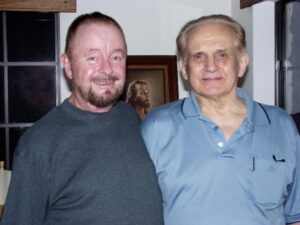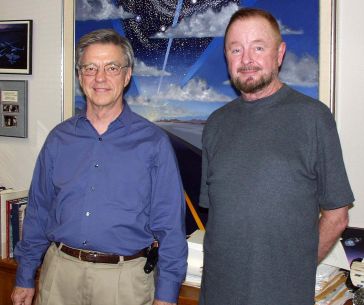In an interesting coincidence, perhaps the two greatest watershed events in remote viewing history took place on the anniversaries of two of the biggest World War II events. As Ingo Swann mentions in this audio clip, the first ever experiment using the new remote viewing protocol that Ingo had created took place in 1971 on December 7th, the 30th anniversary of the Japanese attack on Pearl Harbor.
The second of these anniversaries is perhaps the most noteworthy. Forty-four years ago today, on June 6, 1972, Dr. Hal Puthoff arranged for Swann to perform what was meant to be a small pilot experiment–essentially a test–to see if Swann really could do what he had told Puthoff he could do. Swann’s claim was that he could affect the innards of a sophisticated electronic device using mental power alone. That date was the 28th anniversary of D-Day, the Allied invasion of Europe, and it arguably had as great an historical significance for remote viewing as the D-Day landings had in world history.
Puthoff wanted Swann to perturb the internal workings of a highly-shielded quark detector. This was really just a sophisticated magnetometer designed to register the passage of infinitesimally tiny subatomic particles. To guarantee that the large device would detect only particles, it had several kinds of shielding that would eliminate virtually any influence coming in from the outside. Except, of course, quarks.
The apparatus was in the basement of the Varian Physics Building at Stanford University. Most of it was buried in the floor, with roughly a two-foot diameter cylinder sticking up out of the cement to mark where the detector was. Upon seeing the device for the first time, Swann wanted to know how he was supposed to mentally influence a device he couldn’t even see. But trusting in his abilities, he went ahead and did as asked.

I won’t go into detail as to what happened. The story is told at length in my book Reading the Enemy’s Mind, in Targ and Puthoff’s Mind Reach, in Swann’s own To Kiss Earth Goodbye and (most completely) in Remote Viewing: The Real Story [Chapters 27-37]. Briefly, Swann successfully perturbed the inner workings of the machine, as demonstrated when the near-by chart recorder produced dramatically irregular tracings just at the precise times when Swann was trying to influence the quark detector. There were several disinterested observers present to verify that neither Swann nor Puthoff had any physical interaction with the device.
But something else happened that Puthoff had not expected. Saying that he couldn’t influence something if he didn’t know how it went together, Swann “looked inside” and accurately described (with some sketching) the inner structure of the quark detector. Significantly, the detector had a unique design, which had never been published. Swann had no way of knowing what the guts of the device looked like so, to Puthoff’s consternation, he went ahead and remote viewed it.
The circumstances under which this astonishing event occurred, and the profound consequences that resulted display more than a touch of the miraculous. The quark detector success led to remote viewing spending 23 years and more as an intelligence tool, and then becoming a widely practiced phenomenon in the civilian world. Yet that success came about through a series of tenuous steps, any one of which could so easily not have happened:
1) Puthoff wanted to do an experiment trying to track down tachyons–subatomic particles that could theoretically go backwards in time.
2) He heard about Cleve Backster, a pioneer in polygraphy, and Backster’s work in detecting remote communications between plants. Thinking that perhaps there might be a connection to tachyons, Puthoff sent an inquiry to Backster.

3) A casual conversation between Backster and Swann led Backster to show Swann Puthoff’s inquiry. At first uninterested, Swann quickly became curious, and initiated an ongoing conversation with Puthoff via letter and phone. Yet Swann was still reluctant to go out to California on a lark.
4) Social infighting and bickering that erupted within Swann’s research circle in New York convinced Swann that it was time to take his talents elsewhere. Shoving his original reluctance aside, he decided to take Puthoff up on his offer and departed for Menlo Park, California on June 4, 1972.
5) In the meantime, Puthoff had mentioned to his colleagues at Stanford Research Institute (SRI) that he was thinking of testing Swann’s abilities. “All these psychics are charlatans,” Puthoff remembers his associates saying. “You’d better have something really good set up” so that cheating or faking was not possible. From that came the idea of using the heavily-shielded quark detector.
As this was happening, an entirely different trajectory of sorts was on a collision course with the Puthoff/Swann time line. Unbeknownst to them, the US intelligence establishment had developed a deep interest in the paranormal research of the Soviets and their cronies in the Warsaw Pact. The East Bloc was spending the equivalent of hundreds of millions of dollars on phenomena that the Central Intelligence Agency and its intelligence community associates didn’t even believe were real.
But the CIA knew that the Soviets only expended precious resources on things that promised a serious bang for the buck. So, believe in the paranormal or not, the CIA had to take the possibility seriously that the Soviets were onto something with their research into ESP, psychokinesis, and related potential human abilities.
Yet the Agency was in a fix. Because of controversies over the Vietnam war, nuclear weapons and other hot-button issues–not to mention the embarrassment of publicly having to appear to take the paranormal seriously–the CIA couldn’t go out and hire just any research university or scientific lab to explore the possible military or intelligence implications of extrasensory perception. They needed a sophisticated research venue that could handle classified defense-related projects. There were a few of those around. But they also needed a scientific team willing to get into something as controversial as paranormal research. That was much harder.
And that’s where the miracle continues.
The Puthoff/Swann quark detector experiment succeeded. Puthoff drafted an informal letter to several of his colleagues describing the experiment and its results. A copy ended up on just the right desk at the CIA. Within a few weeks, two men in suits knocked on Puthoff’s office door at SRI. One held up a copy of the report. “Did you write this?” he asked. With that, the Star Gate remote viewing program was born.
Think, though, how this could so easily have failed to happen. Puthoff might never have learned of Backster, or never have speculated that the polygraph expert could help with tachyon research. Backster and Swann might not have had the casual conversation that led Backster to show Swann the letter from Puthoff. The uproar in Swann’s research circle that persuaded Swann to go a different way might never have happened, or he might have come to a different solution than deciding to visit a scientist he’d never met. (Swann was right on the verge of giving up his activity in parapsychology research anyway.) Finally, Puthoff might not have been able to arrange access to the quark detector, which was leagues beyond any device that anyone had tried to mentally influence. Affecting much smaller systems was something Swann had done, but without the historic impact that affecting this one had.
Then there was the CIA side of things. Puthoff’s letter might never have gotten to the CIA. Or it might have ended up on some other desk in the massive, world-wide institution. Or Puthoff, with just the right background, might not have been hired barely a year before by SRI, which just happened to have the right environment to offer what the CIA needed. Because, you see, before leaving government service to enter academia to become a quantum physicist, Puthoff had as a naval officer and then as a civilian worked for the National Security Agency. He had the highest security clearances, even though he wasn’t now working in a classified field. And it turned out that much of SRI’s business was in secret defense-related research. Puthoff and SRI were a perfect match for what the CIA needed.
I’m not oblivious to the fact that many other stories in the fabric of human experience have equally fragile causal links. How you met and married your spouse; how you got into your dream job; how you avoided death in a freak accident; how thanks to a series of improbable events you ended up in a prominent position–any one of these could seem (and maybe really are) miraculous in their own right.
But remote viewing is a larger story, one that none of us involved in now nor any of you reading this today would know anything about if certain things had not happened in a certain way to bring about that epiphany exactly 44 years ago today. Thanks to things working out the way they did, we have the remote viewing story to share together. It’s a true story that has grown over the past years, and that will grow to be even bigger and more significant as we move into the future.
